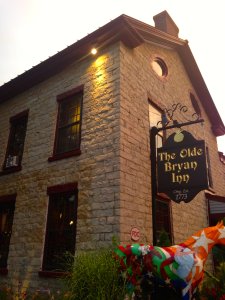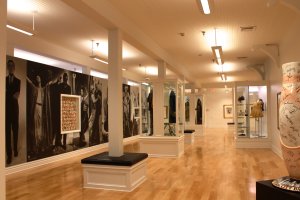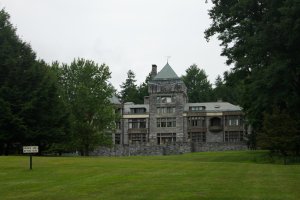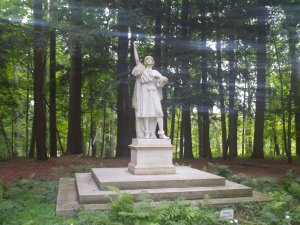
Catch up on Part One (Lake George, Saratoga Springs History Museum) here.
Our second overnight of the trip: the Batcheller Mansion Inn.
Built in 1873 by George Sherman Batcheller, the mansion has some extremely unique architecture—influences of High Victorian Eclecticism, combining French Renaissance Revival, Italianate, and Egyptian. The front doors (massive and ornate wood) welcomed us into the foyer and we were instantly astounded by the grandeur. We were to stay in Amelia’s room on the second floor.

Amelia was Kate Batcheller’s partner for over 33 years—a relationship accepted by her family. Amelia’s personal portrait of Kate sat on the dresser in our most unique room yet. The bathroom was in the turret of the mansion (a totally round bathroom!) and the shower built into a closet behind a curved door! We had a narrow little hallway connecting our room and the bathroom … something we did not look forward to when it got dark.
After ooh-ing and aah-ing at our room, we went to the Olde Bryan Inn for dinner. The decor was awesome—rustic and historic. The food was so wonderful! Lauren, at 23 years old, (keep in mind we’re part Italian), ate ravioli for the first time. *Applause*

What began in 1773 as a crude log cabin, was then improved in 1774 to be an inn, then changed hands several more times before it landed in the hands of Revolutionary War hero Alexander Bryan. Bryan was the first hotelier in Saratoga Springs until 1801. His son took it over in 1825 and made additions and renovations, as did several owners after that. It eventually became the Olde Bryan Inn, a charming restaurant, in 1986. (Read the complete history here.)
On our way out, Lauren was grabbing a ton of brochures (as usual). I told her to stop and then she showed me a printout detailing ghosts at the restaurant! Little did we know we were sleeping AND dining with spirits in Saratoga.
It was dark as we went back to the Batcheller Mansion, which was illuminated by spotlights from the garden, giving it a very eerie look. Lauren wasn’t as enthusiastic as when we first arrived and I was thankful we had turned off the classical music playing on our clock radio. We had a quiet night of calling the parents, making notes, and Laur taking copious amounts of pictures of the room.

The next morning, we enjoyed a wonderful breakfast downstairs with other guests. Pastries, bagels, and fruit were out in the dining room and then you could order eggs, bacon, and/or sausage to your liking. I used the opportunity to ask the staff about any paranormal encounters they may have had at the mansion.
Alice, a wonderfully sweet woman, said she hasn’t really had any experiences. She did say that every once in a while, the dining room smells like a wet dog; which is such a distinct smell! She called Mike over, who she said in his short time at the inn, he’d already had an experience.
Mike said he was working in the basement (what used to be the boiler room, but was now the laundry room) when his first ghostly experience happened. He had his back to the door and was sorting laundry when he thought he heard someone say, “It’s late.” The more he thought about it and replayed it in his head, he realized it actually sounded more like, “Hi, Mike.” He said he never keeps his back to the door anymore!
Mike also mentioned that a new staff member heard a conversation between a man and a woman when she was in the basement. A previous innkeeper heard knocking on a door when no one was there—as well as a cabinet door opening very slowly, all on its own.
After breakfast, we made a quick, unplanned stop at the National Museum of Dance and Hall of Fame—as soon as it opened! Both of us having danced for most of our lives, we couldn’t pass it up. Neither one of us even knew there WAS a national museum. It is located in the former Washington Bathhouse building, and filled with beautiful costumes and photos of America’s most famous artists.

It was a gorgeous, bright space, but we both left melancholy, missing our days on the stage.
Yaddo Gardens was our next and last stop in Saratoga Springs! Yaddo itself is a large artists’ community. Artists can apply for residencies from two weeks to two months to work uninterrupted on the peaceful 400-acre estate. Daron Hagen, an artist who spent the better part of two decades at Yaddo (and has one of the most well-known ghost stories from it) described the community better than I could ever hope to in a blog for the Huffington Post:
“Yaddo is a safe haven for souls painfully familiar with the deafening solitude that is an intrinsic part of our corporeal existence. It is a Genuinely Good Place where artists create things of beauty and goodness that bridge the gap between souls.”
Once you read the story of the Trasks, the founders of Yaddo, that quote will truly give you an image of what they built and why they built it.

The Ghosts in the Yaddo Gardens tour began in September, but Lauren and I, along with Annamaria from Saratoga County, were lucky enough to have Donna from Yaddo give us a sneak peek!
The history of Yaddo and the Trask family is quite unbelievable. The property was settled by Dutchman Jacob Barhyte during the American Revolution. It was a mill, tavern, and farm before the Trask family bought it in 1881. Even before they bought it, it was a destination for well-known writers. Edgar Allan Poe is said to have written part of “The Raven” on the grounds.
Spencer and Katrina Trask used Yaddo as their summer home, rebuilding the main mansion in 1893 after a fire destroyed the original. The name “Yaddo” came from their daughter Christina, who said it rhymed with “shadow.”
Some rumors say the Trask children drowned in a lake. Although all four did perish, that rumor is untrue. Their first child, Alan, died from meningitis at the age of five in 1880 (the Yaddo estate was purchased soon after to provide some distance from the tragedy). In 1888, Katrina caught diphtheria, and her children Christina and Spencer Jr. came to say goodbye to their dying mother. A week later, they both died within two days of each other, while Katrina recovered. Christina was 11 and Spencer Jr. was five. Young Katrina, born a year after that tragedy, died three days after she was born.

The tragedy did not end there. Spencer died in December 1909 in a horrible train wreck—his personal railroad car was hit by a freight train that ran a stop. He was the only one killed.
Katrina married family friend (and long-time admirer) George Foster Peabody six months before her death in 1922, so he would help carry on the Yaddo vision. Yaddo exists today through contributions from private donors, organizations, and past artists.
Katrina always felt the Yaddo grounds were a unique and spiritual place. After the deaths of their children, while deciding what to do with the estate, Katrina wrote “an unseen hand seemed laid upon me,” giving her the vision to make it an artist’s community. That was just the beginning …
The Christalan statue, a memorial to the four Trask children, stands for youth, chivalry, and victory over mortality. Each side has one of the children’s names on it. There are also four separate statues, one for each season, and some say each child, in the gardens. Huge, at least two-foot auras have been seen around each of them—with Christina’s going in the opposite direction and almost four times the size of the others. Each statue also had an orb above it in pictures captured by artists and visitors.

Several artists who have resided at Yaddo have had strange, unexplainable experiences. Daron Hagen said he saw Katrina floating down the steps; novelist Doug Unger was at the top of the stairs and saw it as well. (Read about Hagen’s experience firsthand here.) Evidently, Stanley Kunitz saw an impression on his bed as if someone else was laying next to him and left Yaddo that night. Rick Moody felt an unseen hand on his throat after performing in his band called “Katrina’s Children” and soon after, heard a woman’s voice telling him to change the name. Edgar Allan Poe’s ghost has also been reportedly seen wandering the grounds.
We thanked Annamaria and Donna for their hospitality, wished we had more time to explore Saratoga, and got back on the road!
Our next stop: Cooperstown. A village known for baseball, we were going to explore a different kind of draw: their lingering spirits.



No comments for this post
Leave a comment